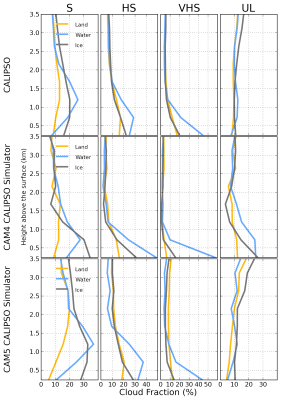Evaluating Arctic Clouds in Climate Models
Arctic clouds are a main controller of the Arctic surface radiative budget, and our global climate models need to accurately produce Arctic clouds in order to to accurately represent Arctic climate. In addition to dynamics and thermodynamics, Arctic clouds respond to changes in surface type (i.e., open water versus sea ice cover). Scientists at Lawrence Livermore National Laboratory (LLNL) developed a method to analyze Arctic clouds during separate dynamics and surface types. In addition, the scientist compared the observed results to the National Center for Atmospheric Research’s (NCAR’s) two most recent global atmospheric models that are used for transient climate change projections, the Community Atmospheric Model Version 4 (CAM4) and Version 5 (CAM5).
The U.S. Department of Energy (DOE) funded Cloud-Associated Parameterizations Testbed (CAPT) framework was used to evaluate CAM4 and CAM5 Arctic clouds to observations. The global atmospheric models were run in forecast mode from May 2008 to March 2010 and the day two forecast was analyzed. The CAPT framework ensured that the dynamics and thermodynamics of the atmosphere were similar to the observations. Arctic cloud observations were largely from the spaced based lidar, CALIPSO, but surface observations were also examined. The global atmospheric models were run with the CALIPSO satellite simulator to ensure that the definition of cloud fraction was similar between the modeled cloud fractions and observed cloud fractions. Observed and modeled clouds were analyzed from 60N to 82N (Northern boundary was due to instrument orbit), and at a 3-hour temporal resolution.
Observations determined that about 90% of Arctic clouds occurred during mid-tropospheric subsidence or very weak uplift. Differences between cloud vertical profiles during the subsidence periods occurred because of differences in the stability of the lower troposphere. Mid tropospheric uplift occurred during the remaining 10% of the study period, and Arctic clouds were present in the mid to upper atmosphere during this period. Arctic clouds were next analyzed during the dominant Arctic synoptic patterns and separated by differences in surface type. The results determined that the cloud response to surface type is dependent on the overlying thermodynamics. From CAM4 to CAM5, there was a large community effort in improving boundary layer processes in the model, and the improved turbulent boundary layer and microphysic parameterizations in CAM5 resulted in more realistic boundary layer cloud.
The authors thank Hélène Chepfer and Gregory Césana for the discussions on the CALIPSO-GOCCP data product. They also thank Matthew Shupe for supplying the surface observations at Eureka, Canada. In addition, the authors thank the anonymous reviewers for their comments that improved this paper. The first author thanks Jennifer Francis, Neil Gordon, Jennifer Kay, and Mark Zelinka for thoughtful discussions. The contribution of N.P. Barton, S.A. Klein, J.S. Boyle, and Y.Y. Zhang to this work was performed under the auspices of the U.S. Department of Energy by Lawrence Livermore National Laboratory under contract DE-AC52-07NA27344. Support for N.P. Barton, S.A. Klein, J.S. Boyle, and Y. Y. Yuying was provided by the Regional and Global Earth and Environmental System Modeling Programs of the Office of Science at the U. S. Department of Energy.

